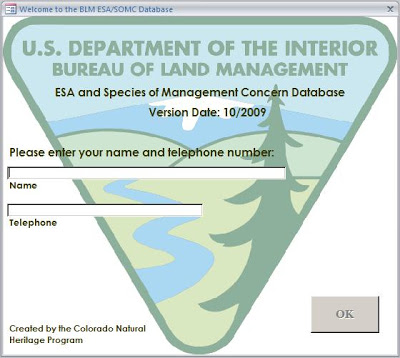Data management is central to the CNHP mission, but we do more than just maintain our Biodiversity Tracking and Conservation System (BIOTICS) Statewide Database that holds information on rare species and plant communities.
For the past two years, CNHP has worked with the Bureau of Land Management (BLM) to develop and maintain a national database for both threatened and endangered species (T & E) and species of management concern (SOMC) on BLM lands. The Federal Land Policy and Management Act (also known as the BLM Organic Act) requires the agency to collect data pertaining to the condition of fish, wildlife and plant resources on BLM-administered lands in order to protect and manage these resources. The Endangered Species Act and the Government Performance and Results Act also mandate record keeping on the status of and expenditures for species that are federally protected or that are considered to be of management concern, so the BLM needed a database solution that would help them manage their information.

Michelle Fink, CNHP Landscape Ecologist and GIS Specialist (who also happens to know a good deal about databases) designed and built BLM’s national reporting T & E and SOMC database. After each BLM field unit reports its data for the year, Michelle then compiles and quality checks and ensures the integrity of the data, updates the national dataset, and summarizes the data for BLM’s reporting needs. The work is more than just a programming and data management task; biological expertise is essential to the entire process due to the complexities of the Endangered Species Act, the dynamic nature of species taxonomy and nomenclature, and the scientific knowledge necessary to appropriately compile, analyze and report scientific species status information. Melissa Landon, CNHP Conservation Data Services Team Leader manages the project and makes sure it all goes smoothly. This past December, Michelle and Melissa completed the coordination of the collection, quality assurance, compilation, analysis and reporting of information for Fiscal Year 2009.
CNHP has also worked with the National Park Service (NPS) for the past nine years on the development of an analogous agency-specific database to assist with annual NPS reporting requirements. Our Conservation Data Services team wears many hats in order to support conservation efforts in Colorado and beyond!




